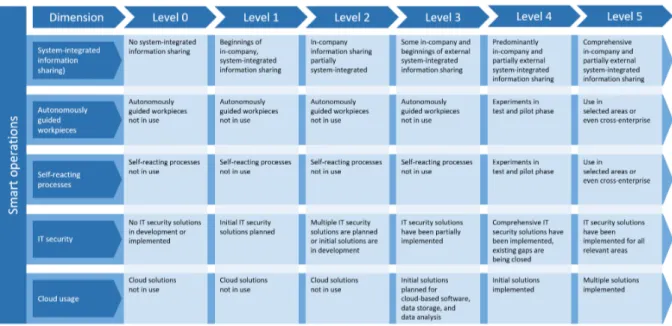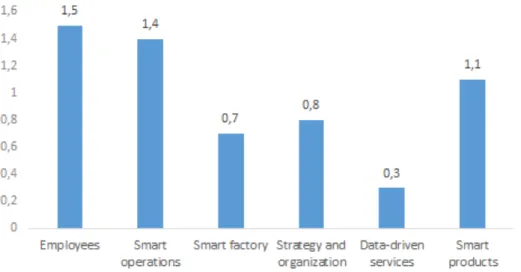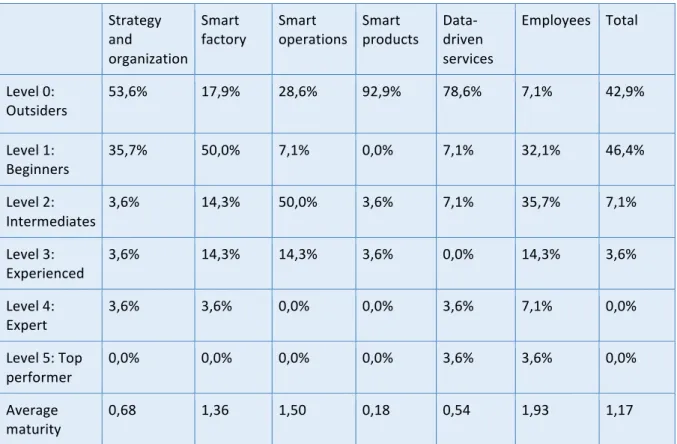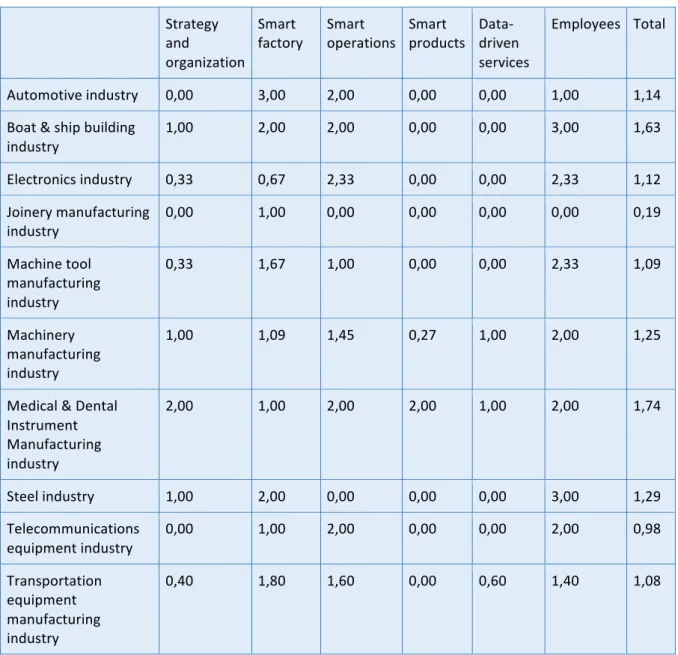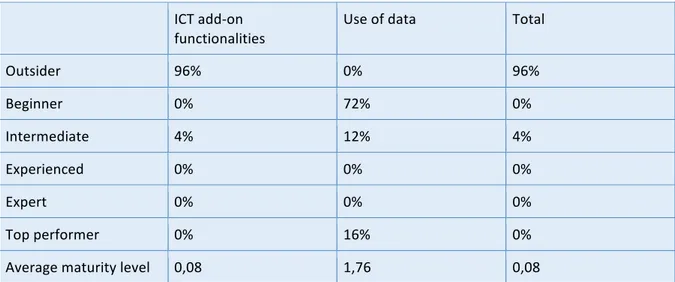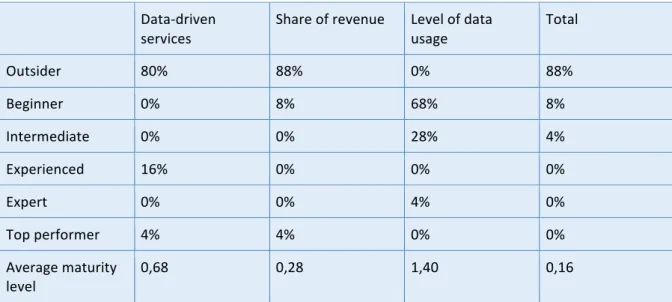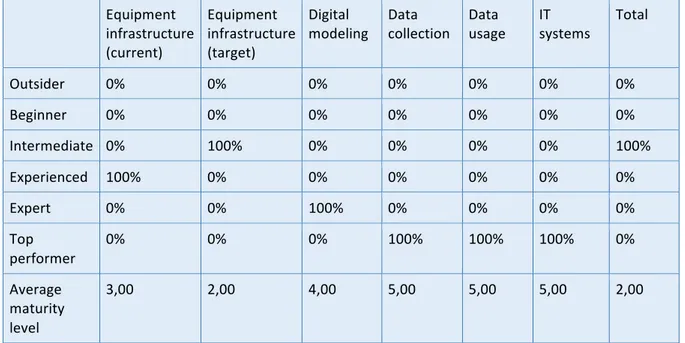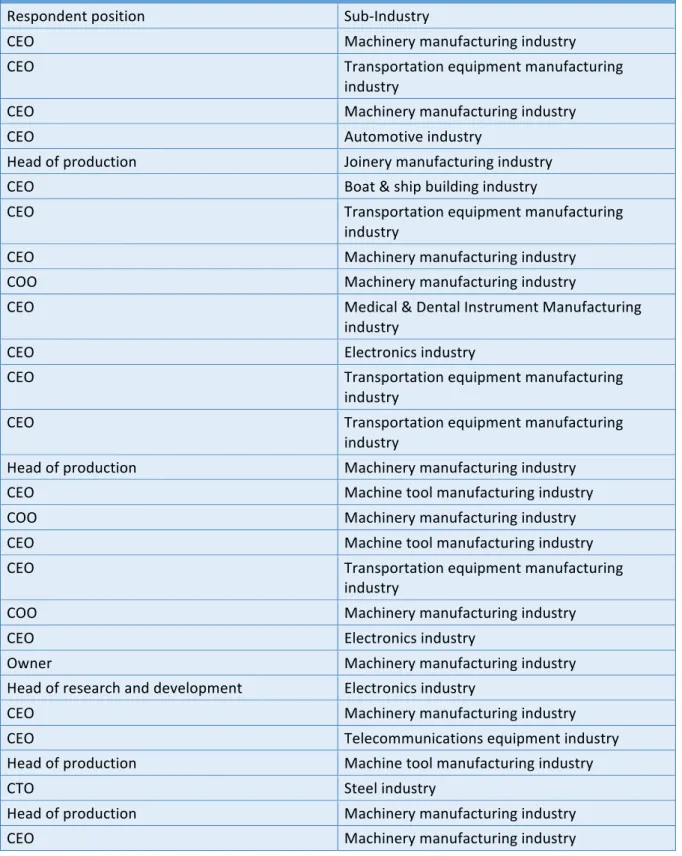Faculty of Engineering LTH
Department of Industrial Management and Logistics
Division of Production Management
Industry 4.0 and Swedish SMEs:
An assessment of current maturity level and challenges
June 2019
Authors
Emin Karimov
John Felix Abrahamsson
Supervisor
Bertil I Nilsson, Lund University
Acknowledgement
This project was run during the spring of 2019 by Emin Karimov and John Felix Abrahamsson as the final part of the M.Sc. program Industrial Engineering and Management at the Faculty of
Engineering, Lund University.
The thesis writing has given the authors a deep understanding of Industry 4.0 in general, but also the specific dynamics related to Swedish SMEs.
We would like to thank our supervisor, Bertil I Nilsson. Thank you for guiding us through this project, for sharing your experience within operations management and for supporting us when facing obstacles – it has been a pleasure to work with you.
We would also like to thank the companies that have contributed to this thesis for taking their time and replying to the survey.
Emin Karimov & John Felix Abrahamsson June 2019, Lund
Abstract
Title
Industry 4.0 and Swedish SMEs: An assessment of current maturity level and challenges
Authors
Emin Karimov, John Felix Abrahamsson
Supervisor
Bertil I Nilsson, Department of Production Management at Faculty of Engineering, Lund University
Background
In a world where the rate of technological change is constantly accelerating, it is getting more and more important for companies to adopt new technologies and processes to stay competitive. Most recently, the concept of Industry 4.0 has emerged as the newest technological paradigm within industrial management and has its roots in the German government’s technological strategy. On a high level, Industry 4.0 is the industrial usage of new technologies, like big data analysis,
autonomous robots, cyber-‐physical infrastructure, simulation, cloud computing, augmented reality and internet of things (IoT) (Ceikcan and Ustundag, 2018). This is enabling machine-‐to-‐machine and human-‐machine interactions and, when implemented successfully, great value creation potential.
Despite that Industry 4.0 is rather new, plenty of papers and consulting reports have been published on the topic. Some of these have indicated that the SME are not quite as well-‐informed, trained and prepared for this shift in paradigm.
Purpose
The purpose of this project is to assess the current level and challenges for Industry 4.0 adoption among Swedish SMEs by using an Industry 4.0 maturity framework to enable further development of the paradigm in Sweden.
Research questions
The thesis has two main research questions:
1. What is the current level of Industry 4.0 maturity among Swedish SMEs?
2. What challenges are Swedish SMEs experiencing when implementing Industry 4.0?
Methodology
The research methodology can be divided into three steps. Firstly, an Industry 4.0 maturity assessment model was chosen from already existing ones, based on three criteria:
comprehensiveness, practicality and proven track-‐record. The Impuls Industry 4.0 assessment model were chosen, which is survey-‐based. Secondly, the survey was sent out to companies and the responses were collected. Lastly, the results were analyzed and discussed based on previous research on the topic.
Conclusions
The main conclusion related to RQ 1 is that the maturity level of Swedish SMEs is low, with an average maturity level of 1,17 on a scale from 0 to 5. No strong relationship was found between maturity level and size or revenue.
The main conclusion related to RQ 2 is that the lack of financial resources, business and customer incompatibility together with technological, knowledge and know how issues are the biggest challenges faced by Swedish SMEs when implementing Industry 4.0. Furthermore, the lack of financial resources is SME specific and had not been identified as a main challenge in previous studies.
Keywords
Industry 4.0, Fourth industrial revolution, Automation, Cyber-‐physical systems, Smart factory Maturity assessment, SME
Table of contents
1 Introduction 1
1.1 Context 1
1.2 Problem 1
1.3 Purpose and key questions 1
1.4 Delimitations 2 1.5 Project objectives 2 1.6 Disposition of thesis 2 2 Methodology 5 2.1 Research strategy 5 2.2 Research design 5 2.3 Research methods 6
2.3.1 Literature review and framework selection 6
2.3.2 Empirical research 7
2.3.3 Analysis and conclusion 8
3 Industry 4.0 maturity models 9
3.1 Assessing Industry 4.0 maturity 9
3.2 Choice of maturity model 9
3.3 The Impuls model 10
3.3.1 Model dimensions 10
3.3.2 Model maturity levels 14
3.3.3 Total maturity score 16
3.3.4 Empirical implementation 17 3.3.5 Adjustment of model 18 4 Previous research 19 4.1 Maturity level 19 4.1.1 Overall maturity 19 4.1.2 Maturity covariates 19 4.2 Challenges 20 4.2.1 Common challenges 20 4.2.2 Type challenges 21
5 Empirical research and results 23
5.1 Maturity level 23
5.1.3 Smart factory 25 5.1.4 Smart operations 26 5.1.5 Smart products 27 5.1.6 Data-driven services 27 5.1.7 Employees 28 5.2 Challenges 29
5.2.1 Strategy and organization 29
5.2.2 Smart factory 29 5.2.3 Smart Operations 29 5.2.4 Smart products 30 5.2.5 Data-driven services 30 5.2.6 Employees 30 6 Analysis 31 6.1 Maturity 31 6.1.1 General 31 6.1.2 Maturity covariates 33 6.2 Challenges 36 6.2.1 Newcomers 37 6.2.2 Learners 40 6.2.3 Leaders 42 7 Discussion 45 7.1 Maturity level 45 7.1.1 General 45 7.1.2 Maturity covariates 46 7.2 Challenges 46 7.2.1 General 46 7.2.2 Newcomers 47 7.2.3 Learners 47 7.2.4 Leaders 47 7.3 Method improvements 47 8 Conclusions 49 8.1 RQ 1: Maturity level 49 8.2 RQ 2: Challenges 49
8.3 Further research suggestions 50
8.4 Contributions 50
Appendix A: Introduction to Industry 4.0 55
Background 55
Core concepts of Industry 4.0 55
Industry 4.0 supporting technologies 56
Impact of Industry 4.0 57
Appendix B: Survey respondent information 59
Appendix C: Distribution of maturity level within sub-dimensions 61
Appendix D: Survey 65
1 Introduction
In the first chapter, the problem and context of the problem is outlined, followed by the purpose of the study, the research questions, the delimitations, the project objectives and lastly the disposition of the thesis.
1.1 Context
In a world where the rate of technological change is constantly accelerating, it is getting more and more important for companies to adopt new technologies and processes to stay competitive. Most recently, the concept of Industry 4.0 has emerged as the newest technological paradigm within industrial management and has its roots in the German government’s technological strategy. Industry 4.0 doesn’t have a clear definition -‐ the German telecommunication association BITKOM has presented over 100 definitions of the concept (Bidet-‐Mayer, 2016). But on a high level, Industry 4.0 is the industrial usage of new technologies, like big data analysis, autonomous robots, cyber-‐ physical infrastructure, simulation, cloud computing, augmented reality and internet of things (IoT) (Ceikcan and Ustundag, 2018). This is enabling machine-‐to-‐machine and human-‐machine
interactions and, when implemented successfully, great value creation potential.
Despite that Industry 4.0 is rather new, plenty of papers and consulting reports have been published on the topic. Some of these have indicated that the SMEs are not quite as well-‐informed, trained and prepared for this shift in paradigm.
1.2 Problem
Industry 4.0 is in an early development stage, but it has a potential to improve the manufacturing industry by bringing significant benefits. However, studies have shown that the potential is realized mainly for large corporations. The concept of Industry 4.0 was mainly developed around large manufacturing companies in Germany, which suggests it could be difficult to be implemented in the Swedish market that consists of 99.8% of small and medium-‐sized companies. Research from Germany shows that there are several problems for German SMEs to adopt and utilize Industry 4.0 to its full potential. The same research states that four out of ten SMEs do not have a comprehensive Industry 4.0 strategy compared with two out of ten among large companies (Schröder 2017). Given this, there is a need to evaluate the Industry 4.0 maturity level of Swedish SMEs.
1.3 Purpose and key questions
The purpose of this project is to assess the current level and challenges for Industry 4.0 adoption among Swedish SMEs by using an Industry 4.0 maturity framework to enable further development of the paradigm in Sweden. The thesis has two main research questions, the first having two additional sub-‐questions. These are the research questions:
1. What is the current level of Industry 4.0 maturity among Swedish SMEs? 1.1. How does the Swedish maturity level compare to Germany?
1.2. What is the relationship between maturity and different covariates: revenue, size and industry?
2. What challenges are Swedish SMEs experiencing when implementing Industry 4.0?
1.4 Delimitations
This thesis is delimited to study SMEs registered in Sweden, categorized as manufacturing companies on businessretriever.se. See section 2.3.2 Empirical research, for more specific survey-‐ related delimitation and reasoning behind them.
1.5 Project objectives
There are two objectives of this thesis. Firstly, to conduct a comprehensive assessment of the current Industry 4.0 maturity level of Swedish SMEs, aggregated into a total maturity score.
Secondly, to outline what challenges Swedish SMEs currently are facing when implementing Industry 4.0.
1.6 Disposition of thesis
This thesis has eight chapters in total, the first being the introduction and the remaining seven are the core content of the thesis. In this subchapter the content of the following chapters is outlined.
Chapter 2: Methodology. In the second chapter the research strategy, design and methods are described. The main part is the research methods, where the three steps of the projects are described.
Chapter 3: Industry 4.0 maturity models. The third chapter presents the reasoning behind the model and the actual model.
Chapter 4: Previous research: The fourth chapter outlines the previous research related to the research questions. That is the theory platform that will be compared with the results. This chapter is divided into two subchapters, one for each of the main research questions.
Chapter 5: Empirical research and results. In the fifth chapter information about the survey respondents and the results of the survey are presented. The chapter is split up into three subchapters. The first is presenting general respondent information and the following two is connected to the two research questions.
Chapter 6: Analysis. The sixth chapter presents the analyzed results. This chapter is divided into two subchapters, one for each of the main research questions.
Chapter 7: Discussion. In the seventh chapter the results of the analysis are discussed from new perspectives not used in the analysis. The part of the chapter is divided into two parts, one for each of the two main research questions. In addition, a discussion regarding method improvements is found in this chapter.
Chapter 8: Conclusions. Lastly, in the eighth chapter, the conclusions of the report are summarized in two subchapters, one for each of the main research questions. There is also a passage on further research suggestions and presentation of contributions of this study.
2 Methodology
In this chapter, firstly the research strategy is outlined, followed by the research design and lastly the research methods are outlined.
2.1 Research strategy
A research strategy is a general approach of doing research. One can divide research strategies into two groups, qualitative and quantitative. This breakdown is relevant due to its effectiveness in classifying different research methods and consequently is more and more frequently used (Bell and Bryman, 2011).
Quantitative research focuses on quantification of the gathering of data and to do analysis on the data sets. Further, quantitative research has three main characteristics (Bell and Bryman, 2011):
-‐ The relationship between theory and research is deductive and data is collected mainly to test hypotheses.
-‐ The epistemological orientation is based on the Natural science model, especially Positivism. -‐ The ontological orientation is incorporating the fundamentals of objectivism, i.e. social
reality is external.
Qualitative research, on the other hand, is focused on words rather than numbers. It has three main characteristics (Bell and Bryman, 2011):
-‐ The relationship between theory and research is mainly inductive and research is done to generate new theory.
-‐ Rejects positivistic approach and instead supports interpretivism, i.e. the social realm cannot be studied with the scientific method applied to nature, instead it is a matter of subjective interpretation.
-‐ The ontological orientation is constructionistic and views social reality as created by the observing actors.
It should be noted though that the distinction is not always as clear as above and the borders between qualitative and quantitative research can sometimes be blurry. Mixed methodologies, where the researcher combines quantitative and qualitative research are common, where one can enjoy the advantages of both strategies (Bell and Bryman, 2011).
As this research topic is relatively young, unexplored and the dimensions of the research questions are complex and consequently hard to quantify, this study will have mainly have a qualitative research strategy, where theory inductively will be created from the empirical data, but it will be mixed with quantitative assessments of qualitative variables.
2.2 Research design
The design of a research depends heavily on its objective, context and problem. Research can usually have different overall purposes (Höst, Regnell and Runesson 2006):
-‐ Descriptive, the main goal of a study is to find out and describe the way something works or how it is being carried out.
-‐ Exploratory, the goal of a study in this case is to understand in depth how something is done or how it works.
-‐ Explanatory, the goal of a study is to highlight the cause and find explanations for how something is done or how it works.
-‐ Problem-‐solving, the main goal of a study is to find a solution for an existing problem that has been identified.
The combination of two or three purposes in one study is possible. For example, a problem could be identified in either descriptive or exploratory study which then will be solved in a problem-‐solving sub-‐study (Höst, Regnell and Runesson, 2006).
For each of the research designs there are different type of tools for data collection and analysis. The tools are usually surveys, interviews, observations and document analysis. There are four generic research designs for master thesis studies within applied science area (Höst, Regnell and Runesson 2006):
-‐ Survey: compilation and description of the current state of the object studied. Often used for mapping and describing a broad case.
-‐ Case study: studying one or several cases in depth, trying not to affect those.
-‐ Experiment: comparative analysis of two or more alternatives, trying to isolate a few factors and manipulate one of them
-‐ Action research: a supervised and documented study of an activity aimed at solving a problem.
This study is conducted using the survey design with a combination of descriptive and exploratory purposes because of the nature of the topic.
2.3 Research methods
This study is divided into three main parts. An overview of this is presented in Figure 2.1 below.
Figure 2.1 Overview of the project methodology.
2.3.1 Literature review and framework selection
The first step of this project was to conduct a literature review, which is described as one of the fundamental methods of research (Höst, Regnell, and Runesson 2006). The literature review had
three different purposes. Firstly, to get a comprehensive understanding of Industry 4.0, the result of this is presented in Appendix A. Secondly, to identify a suitable way of measuring Industry 4.0 maturity for SMEs in Sweden -‐ selecting a maturity assessment framework. This part is presented in Chapter 3, Industry 4.0 maturity models. And lastly, existing studies on the topic of Industry 4.0 maturity was compiled in Chapter 4, Previous research. It is with this the results of the survey will be compared.
Three databases were used when searching for literature, Lubsearch, Scopus and Google Scholar. The search words were:
-‐ Maturity model -‐ Readiness model -‐ Assessment -‐ Framework
The search words were used in combination with “Industry 4.0” and with and without “SME”.
In order to fulfill the second purpose of finding a maturity model, a more structured literature review was conducted. After filtering search results for topic relevance, credibility and publication date (only articles published after 2013, due to the novelty of the topic), 15 models were identified. The models come mainly from academic publications, but some consultancy reports were included to get a deeper pool of models.
Models where assessed from three criteria, which were determined after reading the models: comprehensiveness, practicality and proven track record.
2.3.2 Empirical research
The data collection part was conducted through an online survey that was available on a particular server and distributed to the respondents via email (Höst, Regnell and Runesson 2006). The survey tool used was Google forms.
The chosen sampling method is simple random sample, where subset is chosen from a larger set. Each participant is chosen randomly and has the same probability of being chosen as the others. This approach contributes a more representative sampling result (Höst, Regnell and Runesson 2006).
The collection of empirical data was realized by using the survey presented in Appendix D. The survey was delivered to the companies by email. Data collection was held during following period: 9/4/2019-‐23/4/2019.
Following criteria was used to select the companies included in this study:
Size: The studied companies will be SMEs, defined as having a yearly revenue of between 2 and 50 million euro and having between 10 and 250 employees (European commission, 2019).
Industry: Manufacturing companies will be chosen as objects of study as it was hypothesized that they would in a higher degree have knowledge of Industry 4.0. Previous studies have done the same delimitation (Lichtblau et al. 2015; Saidatul et al. 2018). Furthermore, the products of the chosen companies have to be customizable. The customization enables the possibility of self-‐optimizing and self-‐guiding of products through a Smart factory. Additionally, the idea of Data-‐driven services is applicable on customizable products only.
Respondent: It is important that the respondent has strategic and operational understanding of Industry 4.0, as the model has a comprehensive approach. No constraint is set on respondent position, but the company will be urged to select a respondent that possess both views of the business.
Sub industries: The targeted companies operate within different manufacturing sub-‐industries and those are presented in Appendix B. Each company was assigned a sub-‐industry by using a database that can be reached through the website allabolag.se.
286 companies received the survey, whereof answers provided by 28 are included in this study. The names of the companies will not be presented due to the privacy preferences.
2.3.3 Analysis and conclusion
In the analysis the results are processed in order to reach deeper conclusions. After the analysis, the results are discussed, where the data is looked at from other perspectives than the core theory. Finally, the main results are summarized in conclusions. The analysis is split up into two main parts, one for each research question. In the first part the results related to maturity level are analyzed and in the second part the results related to challenges are analyzed.
The first part is further split up into two sub-‐parts, one part where the total and dimension maturity level is analyzed by comparison with the previous research and one part in which the aim is to identify patterns in the maturity level by plotting against other covariates from the data, specifically revenue, size (small or medium-‐sized) and sub-‐industry. The first sub-‐part is more of qualitative character, whereas the second is of a more quantitative character.
In the second part the companies are categorized based on their maturity level. After that, conclusions are drawn both based on a qualitative analysis of the survey results and a qualitative analysis on the open-‐end questions, by comparing them to the theory.
3 Industry 4.0 maturity models
In this chapter the result of the maturity model literature review is presented, with emphasize on explaining the chosen model, the Impuls maturity model.
3.1 Assessing Industry 4.0 maturity
Assessing maturity for Industry 4.0 at company level is usually based on self-‐assessment. Information needed for the assessment is generally collected through internet surveys and sometimes by phone interviews. The surveys target in most cases general information on enterprises, manufacturing and branch specific data (Rajnai and Kocsis, 2018). Similar approach can be observed at global level (The Boston Consulting Group, 2016). The same approach is used in this study.
There are general maturity models, e.g. Project Management Maturity Model (Seesing 2003), not specifically focusing on Industry 4.0. Given the cutting edge nature of Industry 4.0, only models designated for Industry 4.0 have been considered.
3.2 Choice of maturity model
The Impuls maturity model will be used in this study as the maturity assessment model. This decision was made by comparing the different maturity models found through the literature review. In this subchapter, the reasoning behind choosing the Impuls model is presented.
The Impuls model was chosen because of three reasons: it is comprehensive, it is practical and it has been tested.
Several models focus heavily on the operational and technological aspects of Industry 4.0 (Qin, Liu, and Grosvenor, 2016; Weyer et al. 2015; Rockwell Automation 2014; Anderl et al. 2015), thus disregarding the fact that Industry 4.0, like all new strategic paradigms, have to be supported by management and an aligned organization (Paton and McCalman 2008; Schuh et al. 2017). Other models focus heavily on the management and organizational aspects of Industry 4.0 (Schumacher, Erol, and Sihn. 2016; Kannan et al. 2017; Ganzarain and Errasti 2016). As Industry 4.0 fundamentally is driven by technological development (Moeuf et al. 2018) and consequently, the operational applications are an essential way of assessing Industry 4.0 maturity. The Impuls maturity model offers a comprehensive way of assessing Industry 4.0, focusing on both the strategic aspects and the technological. The model is built on six dimensions, three of them being more technological (Smart products, Smart operations and Smart factories), two of them being strategic or organizational (Employees and Strategy and organization) and one lying in the intersection (Data-‐driven services). There are other maturity models that succeed in doing this (Jung et al. 2016; Geissbauer et al. 2016; Schuh et al. 2017; Scremin et al. 2018; Mittal et al. 2018). The Impuls maturity model was chosen among the 2-‐dimensional maturity models due to its practicality. The other models are more conceptual (Geissbauer et al. 2016; Schuh et al. 2017; Scremin et al. 2018; Mittal et al. 2018) or statistical (Jung et al. 2016), whilst the Impuls model has clearly defined dimensions and levels within each dimension, making it more suitable for this study. Also, the Impuls model has proven its
It has been argued that the Impuls maturity model fails to consider the limitations of SMEs when it comes to implementing Industry 4.0 (Mittal et al. 2018). Specifically, it is argued that the Impuls maturity model doesn’t take into account limitations regarding technological resources availability, employee participation and organizational culture (Mittal et al. 2018). The model however has successfully been applied on SMEs in previous studies, suggesting it does work in practice when it comes to SMEs (Lichtblau et al. 2015; Saidatul et al. 2018).
3.3 The Impuls model
The Impuls maturity model is created by the Impuls Foundation, a think tank part of the mechanical engineering industry association in Germany, VDMA (VDMA, 2019). Their goal is to support German manufacturing companies, in this case by creating an Industry 4.0 maturity model and assessing the current maturity of German manufacturing corporations, as they have identified Industry 4.0 as a pivotal driver of development in the industry (Lichtblau et al. 2015).
The model was created in two steps. Firstly, an extensive review of existing literature was made. Secondly, interviews and workshops with companies that were experienced within Industry 4.0 were held together with scientists from Cologne Institute for Economic Research. Together they identified success-‐factors related to Industry 4.0. These factors then constituted the basis for the dimensions of the model.
3.3.1 Model dimensions
As a result of their research, the Industry 4.0 maturity model of the Impuls Foundation of VDMA is based on six dimensions, each dimension being defined by a number of sub-‐dimensions.
3.3.1.1 Strategy and organization
Industry 4.0 is not only about improving processes and products in companies by using technologies. It encourages the development of entirely new business models (Lichtblau et al. 2015). This is encapsulated in the dimension Strategy and organization. The criteria listed in Figure 3.1 are used to get an understanding of the maturity level inside this dimension.
Figure 3.1. Maturity Model for the dimension of Strategy and organization – minimum requirements. (Lichtblau et al. 2015).
Smart factory
The concept of the Smart factory implicates a production environment where the production systems and logistics systems are able to organize themselves without any interaction with humans. In this environment the workpieces will autonomously guide themselves throughout the production processes, while simultaneously controlling and monitoring the processes too. One of the most crucial parts of the Smart factory is cyber-‐physical systems (CPS) which act as a link between the physical and virtual worlds by a communication through an IT infrastructure. Placement of
comprehensive sensor technology at strategic data collection points throughout the factory and on the machinery and systems is another key future of the Smart factory. This will enable capturing of all the relevant process-‐ and transaction related data in real time and analyzing it for mapping the order processing. It will also ensure that the resources are used efficiently (Lichtblau et al. 2015).
The maturity within the dimension Smart factory is measured on four criteria: digital modeling, equipment infrastructure, data usage and IT systems. These criteria are broken down into six sub-‐ dimensions, which are illustrated in Figure 3.2.
Figure 3.2. Maturity Model for the dimension of Smart factory – minimum requirements. (Lichtblau et al. 2015).
3.3.1.2 Smart Operations
The enterprise-‐wide and cross-‐enterprise integration of the physical and virtual worlds is one of the fundamental characteristics of Industry 4.0. The digital transformation and the huge amount of data this integration brought with it have made it possible to develop entirely new supply chain
management and production planning approaches. Smart operations imply the technical
requirements in production and production planning needed for realizing the self-‐guided workpieces (Lichtblau et al. 2015).
Industry 4.0 maturity in the area of Smart operations is determined using the following four criteria: information sharing, cloud usage, IT security and autonomous processes. The details and
requirements for each criterion are found in Figure 3.3.
Figure 3.3. Maturity Model for the dimension of Smart operations – minimum requirements.
(Lichtblau et al. 2015).
3.3.1.3 Smart products
Smart products are physical products equipped with information and communication technology, ICT, components (sensors, RFID, communication interface etc.) which enables data collection on their environment and their own status. Once the products gather the needed data and know their way through the production while simultaneously communicating with a higher-‐level system, the production processes can be improved and be self-‐guided in real time. This also adds a possibility of optimizing and monitoring the status for a particular product and builds the base for Data-‐driven services, where customers can communicate with manufacturers (Lichtblau et al. 2015).
The maturity level in this dimension is determined by looking at the ICT add-‐on functionalities of products of the company and the extent to which data from the usage phase is analyzed at different levels in company e.g. product development, sales support or after-‐sales (Lichtblau et al. 2015). In Figure 3.4 the sub-‐dimensions are presented.
Figure 3.4. Maturity Model for the dimension of Smart products – minimum requirements. (Lichtblau et al. 2015).
3.3.1.4 Data-‐driven services
Data-‐driven services is about companies evolving from only selling products to providing solutions. One of the most important features of Industry 4.0 is a total reconsideration of existing business models. Companies should focus more on the benefit to the customer and will get an opportunity to both digitize their existing business models and develop new. The after-‐sales and other services will be based on the evaluation of collected data. To make the data collection possible the sold physical products have to be equipped with sensors so they can send, receive and process the necessary information (Lichtblau et al. 2015). Maturity level in this area of Data-‐driven services is determined by looking at three criteria demonstrated in Figure 3.5.
Figure 3.5. Maturity Model for the dimension of Data-‐driven services – minimum requirements. (Lichtblau et al. 2015).
3.3.1.5 Employees
Changes in the workplace driven by digitalization, highly affect the employees. The working
environment that they are used to is changed, making them learn new skills and qualifications. This is the reason why the companies that are going through a digital transformation should prepare their employees for these changes through suitable training and education. The maturity level in this area is determined by looking at the employees existing skills in different fields and the efforts that the company makes in order to acquire new skills and qualifications (Lichtblau et al. 2015), which can be seen in Figure 3.6.
Figure 3.6. Maturity Model for the dimension of Employees – minimum requirements. (Lichtblau et al. 2015).
Each of these six dimensions is further decomposed into 18 fields, which in turn groups their respective indicators and constitutes the basis for measuring the Industry 4.0 maturity of the companies (Lichtblau et al. 2015). An overview of this is presented in Figure 3.7.
Figure 3.7. Dimension and associated fields of Industry 4.0. (Lichtblau et al. 2015).
3.3.2 Model maturity levels
Based on the indicator values, a six-‐level model for measuring Industry 4.0 maturity has been developed. Each of the six maturity levels (0 to 5) includes minimal requirements that companies have to meet in order to complete the level (Lichtblau et al. 2015).
The six levels of the Maturity Model can be described as follows:
Level 0: Outsider. At this level companies do not meet any of the Industry 4.0 requirements.
Level 1: Beginner. Involvement in Industry 4.0 at this level is characterized through pilot initiatives in various departments and investments in a single area. IT systems in the company supports only a few production processes. The future integration and communications requirements are only partially satisfied by the existing equipment infrastructure in the company. The information sharing through the systems in the company is limited to a few areas. IT security solutions are only in planning or implementation phase. At this level companies make first steps in direction of IT-‐based
add-‐on functionalities for their products. The employee skills needed for developing Industry 4.0 are only found in few areas of the company (Lichtblau et al. 2015).
Level 2: Intermediate. At this level companies incorporate Industry 4.0 into their strategic
orientation. A strategy for Industry 4.0 implementation and the appropriate indicators for measuring the implementation status are being developed. Investments are only made in a few areas. Some data within production areas is being automatically collected and used to a limited extent. The future expansion is not supported by the equipment infrastructure. Internal information sharing is integrated in the systems to some extent. Even integration of information sharing with business partners are being taken into consideration and first steps are being taken for the realization too. IT security solutions are in place and being expanded. At this level companies are making products with the first IT-‐based add-‐on functionalities. The employee skills for expanding Industry 4.0 can be found in some areas (Lichtblau et al. 2015).
Level 3: Experienced. At this level an Industry 4.0 strategy is formulated. The company is making Industry 4.0 related investments in multiple areas and starts to promote the introduction of Industry 4.0 in its departments through innovation management. The linkage between IT systems is
supported by an appropriate interface. The IT systems support the production processes too and data is collected automatically in key areas. The equipment infrastructure is upgradable and supports the future expansion. In-‐company and cross-‐enterprise information sharing is enabled by and partially integrated into the system. Necessary IT security solutions have been implemented and cloud-‐based solutions are planned to accommodate further expansion. This environment enables the company to make products with several interconnected IT-‐based add-‐on functionalities. These products create the basis of the fundamental Data-‐driven services, but the company still lacks the integration with the customers. The Data-‐driven services account for a very small part of revenues. Employees’ skill sets are expanded through extensive efforts (Lichtblau et al. 2015).
Level 4: Expert. Expert companies are using a comprehensive Industry 4.0 strategy and monitoring it with appropriate indicators. Industry 4.0 related investments are being made in almost all relevant areas. The investment process is supported by interdepartmental innovation management. The IT systems are used to support most of the production processes and collect large amounts of data for further process optimization. Further expansion in companies are possible due to the existing equipment already satisfying future integration requirements. Both internal and cross-‐enterprise information is largely integrated into the system. IT security solutions are used in the relevant areas and IT is possible to scale through cloud-‐based solutions. Autonomously guided workpieces and self-‐ reacting processes are being explored. Both workpieces and the end products feature IT-‐based add-‐ on functionalities which in turn allow data collection and targeted analysis during the usage phase. The Data-‐driven services enable direct integration between the customer and producer. The necessary employee skills for the further developing of Industry 4.0 can be found in most of the relevant areas (Lichtblau et al. 2015).
Level 5: Top performer. Top performer companies have successfully implemented Industry 4.0 strategy and are regularly monitoring the implementation status of other projects. This is achieved through investments throughout the company. Enterprise-‐wide innovation management is
successful implementation of a comprehensive IT system support. All the requirements for integration and system-‐integrated communications are satisfied by the existing equipment
infrastructure, which in turn makes system-‐integrated information sharing possible, both inside the company and cross-‐enterprise. Comprehensive IT security solutions have been implemented across all the areas and cloud-‐based solutions deliver a flexible IT architecture. Autonomously guided workpieces and self-‐reacting processes are being used in some areas. Both workpieces and products feature extensive IT-‐based add-‐on functionalities which in turn allow data collection and usage of this data for functions such as product development, remote maintenance and sales support. The Data-‐driven services for customers account for a substantial share of revenues and the producer is fully integrated with customer. The company has a well-‐developed employee skill in all needed areas and can move forward with Industry 4.0 (Lichtblau et al. 2015).
In order to make it possible to better summarize the results and draw conclusions about progress and conditions relating to Industry 4.0, the six maturity levels can be grouped into three types of company (Lichtblau et al. 2015):
-‐ Newcomers (level 0 and 1) describe those companies that have done either nothing at all or very little in terms of facing Industry 4.0.
-‐ Learners (level 2) are the companies that have taken the first steps towards Industry 4.0 implementation.
-‐ Leaders (level 3 and up) are the companies that are well on the way to implementing Industry 4.0.
Figure 3.8. Six levels of Industry 4.0 Maturity Model. (Lichtblau et al. 2015)
3.3.3 Total maturity score
The company gets ranked and assigned maturity level in each of the six dimensions based on the lowest score of the sub-‐dimension within the given dimension. For example, if under Smart factory a company gets the highest level 5 in three fields and level 1 in one field, then the maturity level for the whole dimension is 1(Lichtblau et al. 2015).
The final six dimension-‐level maturity score is calculated as a weighted average of the maturity scores of the six dimensions. The weights are determined based on the importance assigned by the
respondent companies to that dimension. (Lichtblau et al. 2015). In this study, the same approach was used and an additional estimation question was added to the main questionnaire.
There are totally 100 possible points, and the six dimensions were weighted as follows based on the average survey responses:
-‐ Strategy and organization -‐ 24 points -‐ Smart factory -‐ 19 points
-‐ Smart products -‐ 17 points -‐ Data-‐driven services -‐ 10 points -‐ Smart operations -‐ 8 points -‐ Employees -‐ 22 points
3.3.4 Empirical implementation
In order to be able to measure maturity, criteria were defined for each of the areas. To move to the next maturity level a company has to meet these criteria. In Figure 3.9 four different scenarios are presented and what the resulting maturity level would be (Lichtblau et al. 2015):
-‐ Scenario A, if the company meets the criteria for the level 1 but not for levels 2 to 5, it will be assigned the maturity level 1.
-‐ Scenario B, here it is not possible to determine whether the company meets the criteria for level 1, since it did not provide any answer (Missing values). However, if the criteria for the level 2 have been met, the missing values from level 1 are interpreted as fulfilling criteria for level 1. The company is therefore will be assigned the maturity level 1.
-‐ Scenario C, no information is available for level 1 and criteria for level 2 is not met. The missing values at level 1 are interpreted as not meeting criteria for the level 1, the company will therefore be assigned level 0.
-‐ Scenario D, if in any given sub-‐dimension, some of the levels criteria are the same, then the highest of those levels will be chosen.
Figure 3.9. Satisfaction of one or more criteria. (Lichtblau et al. 2015)
3.3.5 Adjustment of model
An additional questionnaire that is mapping fundamental aspects of the company and company representative will be added as a part of the survey sent to companies. The following six questions will be asked:
1. What’s the name of your company? 2. What’s your position at the company? 3. What was your revenue 2018?
4. What’s your employee count?
5. Are your company aware of Industry 4.0?
In addition to the core model suggested by the Impuls Foundation, open-‐end question for each dimension was added:
What do you experience as the main challenges when it comes to implementing this dimension of Industry 4.0?
4 Previous research
In this section result from previous research related to the research questions are presented.
4.1 Maturity level
In this subsection, the previous research related to RQ 1 is presented.
4.1.1 Overall maturity
Research has indicated that the maturity level of large, Swedish manufacturing companies is low (Antonsson, 2017). However, the same study showed that the implementation of Industry 4.0 indeed has been initiated and that there are some companies that have already achieved high maturity.
In the original Impuls study, the maturity level in Germany was found to be low with a total average maturity level of 0.6 for the manufacturing industry as a whole and 0.9 for the sub-‐industry
mechanical engineering industry (Lichtblau et al. 2015). The maturity is distributed between the different dimensions in accordance with Figure 4.1.
Figure 4.1. Average maturity level in each dimension for German companies. Source: (Lichtblau et al. 2015).
4.1.2 Maturity covariates
As part of RQ1, the maturity level will be compared against three covariates, revenue, size and sub-‐ industry. In this section, the previous research related to this is presented.
4.1.2.1 Revenue
It has been found that there is no correlation between revenue and Industry 4.0 maturity level for manufacturing companies in Sweden (Antonsson, 2017). This study was conducted on only large corporations and the researcher mentions that this could be the reason why no such relationship
